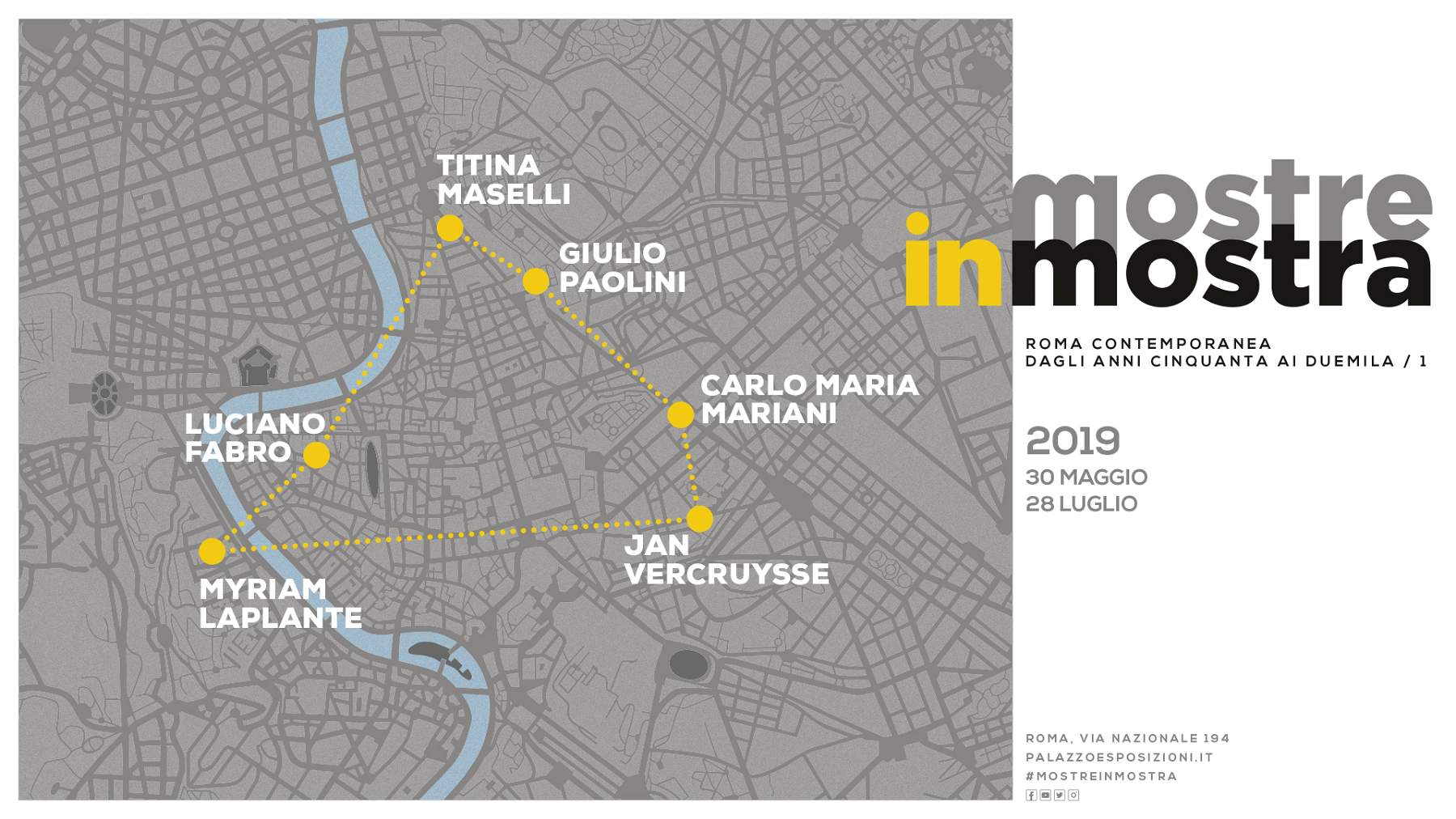In Rome, an exhibition... about exhibitions: six major twentieth-century exhibitions re-enacted at the Palazzo delle Esposizioni
he Palazzo delle Esposizioni in Rome presents, from May 30 to July 28, 2019, Mostre in mostra, an exhibition project curated by Daniela Lancioni, promoted by Roma Capitale Assessorato alla Crescita culturale and organized byAzienda Speciale Palaexpo. The aim of the review is to give voice to the plurality of figures and places that in Rome, from the middle of the last century onward, have been able to renew, each time in a different way, the contemporary vocation of the City. The initiative will be repeated every year at the Palazzo delle Esposizioni with in-depth looks at different protagonists and exhibition spaces. In this first edition, six major exhibitions that took place in Rome in the individual decades between the 1950s and the 2000s will be presented again in the rooms revolving around the rotunda: Titina Maselli, Galleria La Tartaruga 1955; Giulio Paolini, Galleria La Salita 1964; Fabro.Concetto spaziale d’après Watteau,1967-71 / Corona di piombo, 1968-71 / L’Italia d’oro / Alluminio e seta naturale, 1971 / Informazioni sulla presenza Italiana edited by Achille Bonito Oliva, Incontri Internazionali d’Arte, 1971; Carlo Maria Mariani. The Lion Constellation, Gian Enzo Sperone Gallery, 1981; Jan Vercruysse. Tombeaux (Room), Pieroni Gallery, 1990; Myriam Laplante. Elisir, curated by Lorenzo Benedetti and Teresa Macrì, Volume! Foundation and The Gallery Apart, 2004.
The more than sixty works on display, including paintings, sculptures and installations, will offer visitors the chance to rediscover, in a sort of walk through time, the exhibition landscapes of a City in which contemporary art has been significantly affecting for many decades. A selection of photographs by Sergio Pucci, a photographer who since the mid-1950s has documented artworks at artists’ studios or on display, working for friends(Ettore Colla, Pericle Fazzini, Leoncillo, Bice Lazzari, among others) or for galleries (amongothers La Salita, Giuliana De Crescenzo, Dell’Oca, Mario Diacono, Primo Piano), will enrich the narratives of the exhibition and provide an important contribution to the historical evocation of the period under consideration.
The journey through the exhibitions will begin with city images painted by Titina Maselli in New York and shown by Plinio De Martiis and Ninnì Pirandello in La Tartaruga in 1955. Thanks to the collaboration of the Giulio and Anna Paolini Foundation and to loans from important collections, Giulio Paolini ’s first solo exhibition, which took place in 1964 in another of Rome’s famous galleries, La Salita, will be remounted on this occasion by the artist himself. By Luciano Fabro, thanks to the support of theLuciano and Carla Fabro Archive, the impressive set of works with which the artist responded in 1971 to Achille Bonito Oliva ’s invitation to exhibit first at the 7th Paris Biennial and then in the newly founded Incontri Internazionali d’Arte association will be collected.
With Carlo Maria Mariani’s large painting, now preserved at the National Gallery in Rome and originally exhibited by Gian Enzo Sperone in 1981, the public will find itself in the presence of a new way of understanding painting and history, and will be invited to share in the praise of the artists, critics and gallery owners, then protagonists of the Roman scene, portrayed in the painting. An entirely different sensibility will dominate the space devoted to Jan Vercruysse and his Tombeaux, severe simulacra of secret memories, exhibited in the Pieroni Gallery in 1990 and now re-presented with the collaboration of the Foundation named after the late artist.
Myriam Laplante’s exhibition, Elisir of 2004, curated by Lorenzo Benedetti and Teresa Macrì, promoted by The Gallery Apart and the Volume! Foundation and hosted by the latter, will conclude the itinerary with an immersion in the artist’s paradoxical and compelling imagination, fairy tale-like and mordant at the same time.
The Mostre in mostra project intends to insert itself in the current debate on the possibility of historicizing contemporary art by choosing to take as its main point of observation the moment of the exhibition and thus give value to the circumstances in which the work becomes a public and shared thing. The reconstruction of the exhibitions, although conducted with the tools of philology (through the documents of the time, testimonies, photographic repertoire, stamps and other signs that the works themselves bear), will not in all cases be strictly faithful. More than the archaeological study, it is of interest to recognize the importance of individual works today and the significance they acquire in the choral vision of an exhibition: a derogation from philology that in the curator’s intentions is also made in the name of the metamorphoses that some works have undergone over time because of their “musealization,” but often also because of the will of their authors. Slippings, additions, absences, metamorphoses: the review wants to try to motivate and analyze each choice, highlighting, exhibition by exhibition, nodes, practical and theoretical arrangements that pertain to the works or the authors or to the historical reconstruction, hoping to open a discussion on these issues to which everyone is invited to participate.
For all information you can visit the official website of Palazzo delle Esposizioni.
 |
| In Rome, an exhibition... about exhibitions: six major twentieth-century exhibitions re-enacted at the Palazzo delle Esposizioni |
Warning: the translation into English of the original Italian article was created using automatic tools. We undertake to review all articles, but we do not guarantee the total absence of inaccuracies in the translation due to the program. You can find the original by clicking on the ITA button. If you find any mistake,please contact us.































